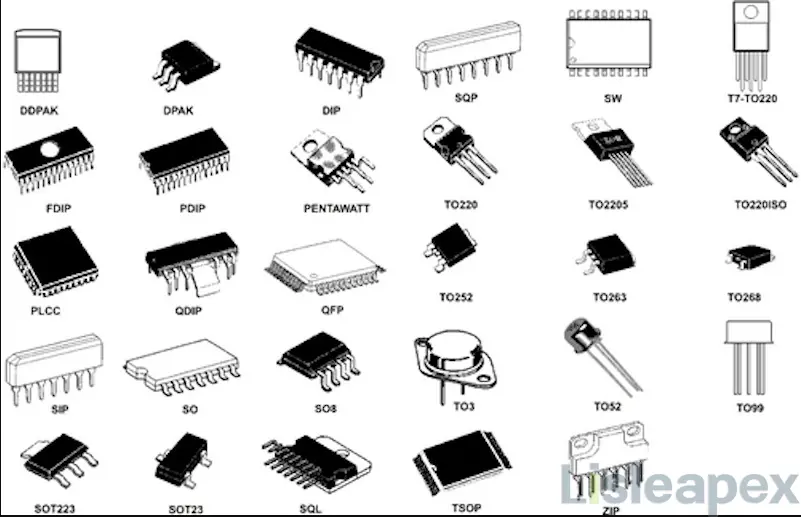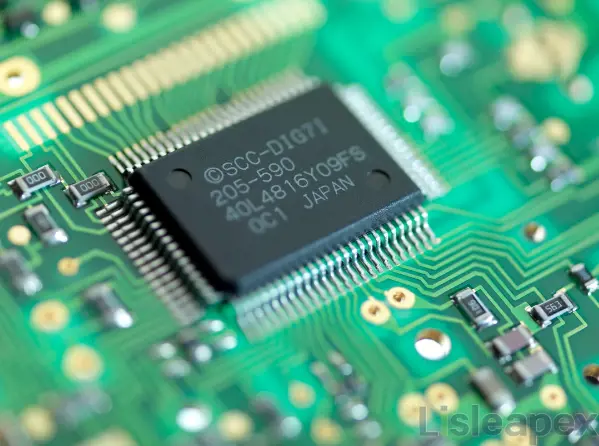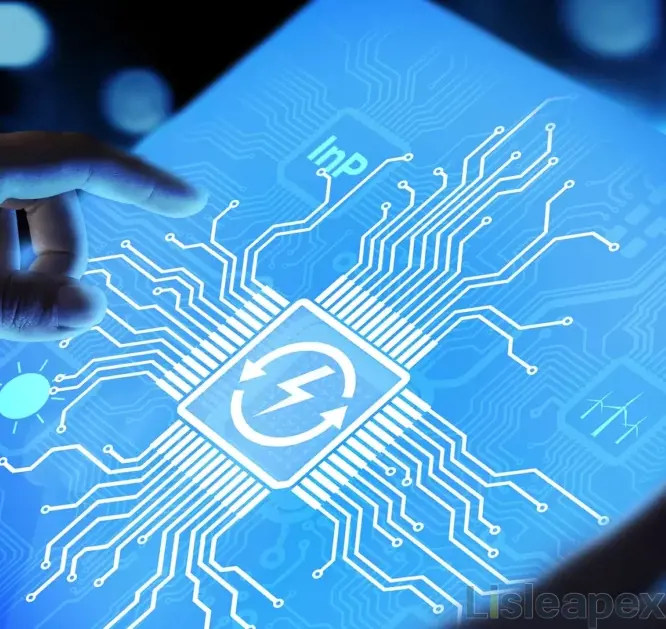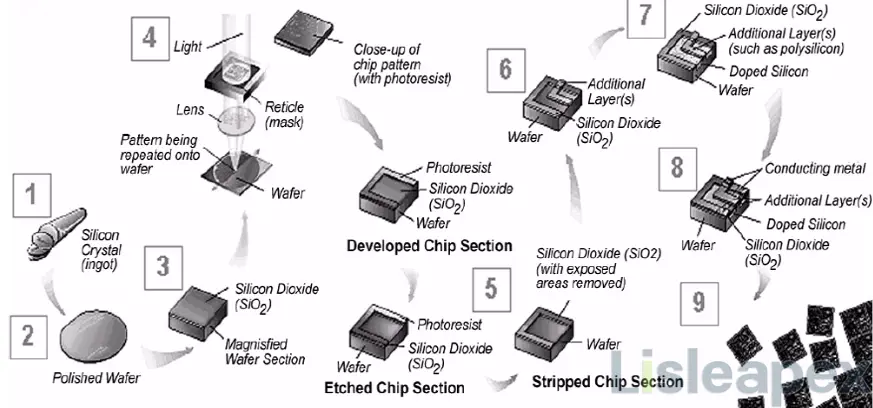Overview
Integrated circuits (ICs) are the unsung heroes of modern electronics, powering everything from smartphones to spacecraft. In this article, we'll delve into the complexities of ICs, exploring what they are, the various types available, their specific functions, the complex manufacturing processes involved, and what makes them an indispensable class in our technology-driven world.
What is IC CHIP and How Does an IC Work
What is an Integrated Circuit (IC)
At its core, an Integrated Circuit is a compact assembly of interconnected electronic components that are etched or imprinted onto a single semiconductor substrate. This integration allows for the creation of complex electronic circuits that once required multiple discrete components, resulting in devices that are smaller, more efficient, and more reliable.
Integrated circuits (ICs) come in various types, each designed for specific functions and applications. Here's an overview of some common types of integrated circuits:
Types of integrated circuits(Kinds of IC)

Analog Integrated Circuits (ICs):
- Operational Amplifiers (Op-Amps): Amplify voltage signals with high gain and are widely used in signal conditioning, filtering, and mathematical operations.
- Comparators: Compare two voltage inputs and output a digital signal indicating which input is larger.
- Analog Multipliers/Dividers: Perform multiplication or division of analog signals.
- Voltage Regulators: Stabilize and regulate the voltage output to power electronic devices.
Digital Integrated Circuits (ICs):
- Microprocessors: Central processing units (CPUs) that execute instructions in computer systems.
- Microcontrollers: Integrated circuits with a CPU, memory, and input/output peripherals, used in embedded systems.
- Digital Signal Processors (DSPs): Optimize the processing of digital signals, commonly used in audio and video processing.
- Field-Programmable Gate Arrays (FPGAs): Configurable digital circuits that can be programmed for specific tasks.
Mixed-Signal Integrated Circuits:
- Analog-to-Digital Converters (ADCs): Convert analog signals to digital for processing in digital systems.
- Digital-to-Analog Converters (DACs): Convert digital signals to analog for applications like audio playback.
- Sensor Interface ICs: Interface with various sensors, converting analog sensor outputs to digital signals.
Memory ICs:
- RAM (Random Access Memory): Provides temporary data storage for quick access by the CPU.
- ROM (Read-Only Memory): Stores permanent data or firmware.
- Flash Memory: Non-volatile memory is used in applications like USB drives, memory cards, and solid-state drives.
Power Management ICs:
- Voltage Regulators: Control and stabilize voltage levels.
- Battery Management ICs: Monitor and manage battery charging and discharging processes.
- Power Amplifiers: Amplify power signals, commonly used in audio or RF applications.
Radio-Frequency Integrated Circuits (RFICs):
- RF Amplifiers: Amplify radio-frequency signals in communication systems.
- RF Mixers: Combine different frequency signals in RF applications.
- RF Modulators/Demodulators: Modulate or demodulate radio-frequency signals for communication.
Application-Specific Integrated Circuits (ASICs):
- Custom-designed ICs: Tailored for specific applications, offering optimized performance and reduced power consumption.
Optoelectronic ICs:
- Light Emitting Diode (LED) Drivers: Control the intensity and pattern of LED lighting.
- Optical Sensors: Convert light signals into electrical signals and vice versa.
Communication Integrated Circuits:
- Ethernet Controllers: Enable communication in local area networks (LANs).
- Wireless Communication ICs: Include components for Wi-Fi, Bluetooth, and cellular communication.
Interface Integrated Circuits:
- UART (Universal Asynchronous Receiver-Transmitter): Facilitates serial communication between devices.
- USB Controllers: Manage data transfer between devices using USB connections.
- I2C and SPI Controllers: Enable communication between integrated circuits in embedded systems.
These categories represent a broad overview, and within each category, numerous specialized ICs are catering to specific applications and industries. Advances in technology continually introduce new types of integrated circuits, expanding their capabilities and applications.
Above is the introduction of what are the Different types of integrated circuits (IC), the following content is for you to do an extended application.
IC Chip package types
Integrated circuits (ICs) come in a variety of package types, each designed to meet specific requirements in terms of size, thermal management, and application. These packages play a crucial role in determining how an IC is mounted, connected, and protected within an electronic system. Here are introduce IC package types:
Through-hole packages
Through-hole packages involve leads passing through holes in the PCB for soldering. They are robust and easy to handle, commonly used in prototyping and for components requiring mechanical stability.
| Acronym | Full name | Remark |
|---|---|---|
| SIP | Single in-line package | |
| DIP | Dual in-line package | 0.1 in (2.54 mm) pin spacing, rows 0.3 in (7.62 mm) or 0.6 in (15.24 mm) apart. |
| CDIP | Ceramic DIP | |
| CERDIP | Glass-sealed ceramic DIP | |
| QIP | Quad in-line package | Like DIP but with staggered (zig-zag) pins. |
| SKDIP | Skinny DIP | Standard DIP with 0.1 in (2.54 mm) pin spacing, rows 0.3 in (7.62 mm) apart. |
| SDIP | Shrink DIP | Non-standard DIP with smaller 0.07 in (1.78 mm) pin spacing. |
| ZIP | Zig-zag in-line package | |
| MDIP | Molded DIP | |
| PDIP | Plastic DIP |
Surface mount
Surface mount packages involve soldering components directly onto the surface of the PCB. They are compact, facilitating automated manufacturing, and are prevalent in modern electronics for their space efficiency.
| Acronym | Full name | Remark |
|---|---|---|
| CCGA | Ceramic column-grid array (CGA) | |
| CGA | Column-grid array | |
| CERPACK | Ceramic package | |
| CQGP | ||
| LLP | Lead-less lead-frame package | A package with metric pin distribution (0.5–0.8 mm pitch) |
| LGA | Land grid array | |
| LTCC | Low-temperature co-fired ceramic | |
| MCM | Multi-chip module | |
| MICRO SMDXT | Micro surface-mount device extended technology |
Chip carrier
Chip carriers provide a protective casing for integrated circuits (ICs). They come in various forms, such as flat or ceramic, offering physical protection and aiding in heat dissipation.
| Acronym | Full name | Remark |
|---|---|---|
| BCC | Bump chip carrier | |
| CLCC | Ceramic lead-less chip carrier | |
| LCC | Lead-less chip carrier | Contacts are recessed vertically. |
| LCC | Leaded chip carrier | |
| LCCC | Leaded ceramic-chip carrier | |
| DLCC | Dual lead-less chip carrier (ceramic) | |
| PLCC | Plastic leaded chip carrier |
Pin grid arrays
Pin Grid Arrays feature pins arranged in a grid on the underside of the IC. This design allows for efficient heat dissipation and is commonly used in processors and other high-performance ICs.
| Acronym | Full name | Remark |
|---|---|---|
| OPGA | Organic pin-grid array | |
| FCPGA | Flip-chip pin-grid array | |
| PAC | Pin array cartridge | |
| PGA | Pin-grid array | Also known as PPGA |
| CPGA | Ceramic pin-grid array |
Flat packages
Flat packages, like the Quad Flat Package (QFP), are thin and have leads extending from the sides. They are versatile, used in various applications, and are known for ease of manufacturing and good thermal performance.
| Acronym | Full name | Remark |
|---|---|---|
| - | Flat-pack | Earliest version metal/ceramic packaging with flat leads |
| CFP | Ceramic flat-pack | |
| CQFP | Ceramic quad flat-pack | Similar to PQFP |
| BQFP | Bumpered quad flat-pack | |
| DFN | Dual flat-pack | No lead |
| ETQFP | Exposed thin quad flat-package | |
| PQFN | Power quad flat-pack | No-leads, with exposed die-pad[s] for heatsinking |
| PQFP | Plastic quad flat-package | |
| LQFP | Low-profile quad flat-package | |
| QFN | Quad flat no-leads package | Also called as micro lead frame (MLF). |
| QFP | Quad flat package | |
| MQFP | Metric quad flat-pack | QFP with metric pin distribution |
| HVQFN | Heat-sink very-thin quad flat-pack, no-leads | |
| SIDEBRAZE | ||
| TQFP | Thin quad flat-pack | |
| VQFP | Very-thin quad flat-pack | |
| TQFN | Thin quad flat, no-lead | |
| VQFN | Very-thin quad flat, no-lead | |
| WQFN | Very-very-thin quad flat, no-lead | |
| UQFN | Ultra-thin quad flat-pack, no-lead | |
| ODFN | Optical dual flat, no-lead | IC packaged in transparent packaging used in optical sensor |
Small outline packages
Small Outline Packages, like SOIC, are compact surface mount packages with a reduced form factor. They are widely used in consumer electronics and offer a good balance between size and functionality.
| Acronym | Full name | Remark |
|---|---|---|
| SOP | Small-outline package | |
| CSOP | Ceramic small-outline package | |
| DSOP | Dual small-outline package | |
| HSOP | Thermally-enhanced small-outline package | |
| HSSOP | Thermally-enhanced shrink small-outline package | |
| HTSSOP | Thermally-enhanced thin shrink small-outline package | |
| mini-SOIC | Mini small-outline integrated circuit | |
| MSOP | Mini small-outline package | Maxim uses the trademarked name µMAX for MSOP packages |
| PSOP | Plastic small-outline package | |
| PSON | Plastic small-outline no-lead package | |
| QSOP | Quarter-size small-outline package | The terminal pitch is 0.635 mm. |
| SOIC | Small-outline integrated circuit | Also known as SOIC NARROW and SOIC WIDE |
| SOJ | Small-outline J-leaded package | |
| SON | Small-outline no-lead package | |
| SSOP | Shrink small-outline package | |
| TSOP | Thin small-outline package | |
| TSSOP | Thin shrink small-outline package | |
| TVSOP | Thin very-small-outline package | |
| VSOP | Very-small-outline package | |
| VSSOP | Very-thin shrink small-outline package | Also referred as MSOP = micro small-outline package |
| WSON | Very-very-thin small-outline no-lead package | |
| USON | Very-very-thin small-outline no-lead package | Slightly smaller than WSON |
Chip-scale packages
Chip-Scale Packages are miniaturized packages, often similar in size to the bare die. They are designed for ultra-compact applications and are prevalent in mobile devices and wearables.
| Acronym | Full name | Remark |
|---|---|---|
| BL | Beam lead technology | Bare silicon chip, an early chip-scale package |
| CSP | Chip-scale package | Package size is no more than 1.2× the size of the silicon chip |
| TCSP | True chip-size package | Package is same size as silicon |
| TDSP | True die-size package | Same as TCSP |
| WCSP or WL-CSP or WLCSP | Wafer-level chip-scale package | A WL-CSP or WLCSP package is just a bare die with a redistribution layer (or I/O pitch) to rearrange the pins or contacts on the die so that they can be big enough and have sufficient spacing so that they can be handled just like a BGA package. |
| PMCP | Power mount CSP (chip-scale package) | Variation of WLCSP, for power devices like MOSFETs. Made by Panasonic. |
| Fan-out WLCSP | Fan-out wafer-level packaging | Variation of WLCSP. Like a BGA package but with the interposer built directly atop the die and encapsulated alongside it. |
| eWLB | Embedded wafer level ball grid array | Variation of WLCSP. |
| MICRO SMD | - | Chip-size package (CSP) developed by National Semiconductor |
| COB | Chip on board | Bare die supplied without a package. It is mounted directly to the PCB using bonding wires and covered with a blob of black Epoxy. Also used for LEDs. In LEDs, transparent epoxy or a silicon caulk-like material that may contain a phosphor is poured into a mold containing the LED(s) and cured. The mold forms part of the package. |
| COF | Chip-on-flex | Variation of COB, where a chip is mounted directly to a flex circuit. Unlike COB, it may not use wires nor be covered with epoxy, using underfill instead. |
| TAB | Tape-automated bonding | Variation of COF, where a flip chip is mounted directly to a flex circuit without the use of bonding wires. Used by LCD driver ICs. |
| COG | Chip-on-glass | Variation of TAB, where a chip is mounted directly to a piece of glass - typically an LCD. Used by LCD and OLED driver ICs. |
Ball grid array
Ball Grid Arrays feature an array of solder balls on the underside of the IC. This design enhances thermal performance and is commonly used in high-density ICs, such as microprocessors and memory modules.
| Acronym | Full name | Remark |
|---|---|---|
| FBGA | Fine-pitch ball-grid array | A square or rectangular array of solder balls on one surface |
| LBGA | Low-profile ball-grid array | Also known as laminate ball-grid array |
| TEPBGA | Thermally-enhanced plastic ball-grid array | |
| CBGA | Ceramic ball-grid array | |
| OBGA | Organic ball-grid array | |
| TFBGA | Thin fine-pitch ball-grid array | |
| PBGA | Plastic ball-grid array | |
| MAP-BGA | Mold array process - ball-grid array | |
| UCSP | Micro (μ) chip-scale package | Similar to a BGA (A Maxim trademark) |
| μBGA | Micro ball-grid array | Ball spacing less than 1 mm |
| LFBGA | Low-profile fine-pitch ball-grid array | |
| TBGA | Thin ball-grid array | |
| SBGA | Super ball-grid array | Above 500 balls |
| UFBGA | Ultra-fine ball-grid array |
Transistors, diodes, and small-pin-count IC packages often come in tiny and compact packages to accommodate highly integrated electronic devices.Here are some common packaging types:
Transistor and Diode Packages
| Package Type | Description | Features |
|---|---|---|
| SOT-23 | Small Outline Transistor with 3 Pins | Compact; Suitable for small power amplifiers, switches, and power applications. |
| SOT-89 | Small Outline Transistor with 3 Pins | Used in medium-power transistors and diodes; Common in power management and linear amplifiers. |
| TO-92 | Transistor Outline with 3 Pins | Classic cup-shaped package; Common for general-purpose transistors and diodes. |
Small Pin Count IC Packages
| Package Type | Description | Applications |
|---|---|---|
| SSOP (Shrink Small Outline Package) | Compact IC Package with Reduced Pin Spacing | High-density ICs in communication, computing, and embedded systems. |
| TSOP (Thin Small Outline Package) | Low-Profile IC Package | Common in storage ICs such as DRAM and flash memory; Suitable for space-constrained applications. |
| QFN (Quad Flat No-Leads) | No-Lead IC Package with Four Sides | Offers effective heat dissipation; Used in ICs like microcontrollers and RF devices. |
Summary of integrated circuit package types
Integrated circuits (ICs) are packaged in various forms to meet specific size, thermal, and functional requirements. Common packages include the traditional Dual In-Line Package (DIP), compact Surface Mount Devices (SMD), and advanced Ball Grid Array (BGA) for efficient heat dissipation. Chip-on-board (COB) eliminates external packaging, while Quad Flat No-Leads (QFN) and Dual Flat No-Leads (DFN) offer space-efficient designs. Each package type serves distinct purposes, enabling flexibility in designing electronic systems for diverse applications.

Functions of Integrated Circuits
| Function | Example ICs | Application |
|---|---|---|
| Processing Functions | Microprocessors, Micro | Computers |
| Memory Functions | RAM, ROM, Flash Memory | Data |
| Analog Signal Processing | Operational Ampl | Signal Amplification, Voltage Comparison |
| Digital Signal Processing | Digital Signal Processors (DSPs) | Audio and Video Processing |
| Communication Functions | RFICs, Ethernet Controllers, Wireless Communication | Wireless Communication, Networking |
| Power Management | Voltage Regulators, Battery Management ICs | Stabilizing Voltage, Battery Control |
| Interface and Interconnection | UART, | Serial |
| Sensing and Control | Sensor Interface ICs, Motor Control ICs | Sensor Data Processing, Motor Control |
| Custom and Application-Specific Functions | ASICs | Custom-Designed ICs for Specific Applications |
| Optoelectronic Functions | LED Drivers, Optical Sensors | Controlling LED Lighting, Light Sensing |
| Timing and Clocking | Clock Generators and Timers | Providing Timing Signals for Synchronization |
| Security Functions | Security ICs | Encryption, Secure Key Storage |
Manufacturing Processes for Integrated Circuits
The creation of integrated circuits involves a sophisticated series of steps:
- Design: Utilizing computer-aided design (CAD) tools to plan the circuit layout.
- Masking: Applying patterns to a semiconductor wafer via photolithography.
- Etching: Removing unwanted material from the wafer using chemical or plasma etching.
- Doping: Modifying specific areas of the semiconductor to create components like transistors.
- Deposition: Depositing layers of materials (metals, insulators) onto the wafer.
- Packaging: Encapsulating individual ICs to protect them from environmental factors.
Categories of Integrated Circuits
- Linear ICs: Amplifiers, voltage regulators, and oscillators fall into this category.
- Digital ICs: Encompassing microprocessors, microcontrollers, and memory devices.
- Power Management ICs: Focused on regulating and distributing power efficiently.
- Radio-Frequency ICs (RFICs): Facilitating wireless communication through RF amplifiers, mixers, and modulators/demodulators.
- Optoelectronic ICs: Involving components like LED drivers and optical sensors.
Applications of Integrated Circuits
| Application Area | Example ICs | Function |
|---|---|---|
| Consumer Electronics | ICs in Smartphones, TVs, Audio Systems | Processing, Memory, Communication |
| Computing Systems | Microprocessors, Microcontrollers | Central Processing Units, Embedded Control |
| Communication Systems | RFICs, Ethernet Controllers, Wireless Communication ICs | Wireless Communication, Networking |
| Automotive Electronics | Automotive Control ICs | Engine Control, Safety Systems, Entertainment |
| Medical Devices | ICs in Medical Equipment | Monitoring, Imaging, Implantable Devices |
| Industrial Automation | ICs in Industrial Control Systems | Automation, Control of Machinery |
| Aerospace and Defense | Avionics ICs, Defense Systems ICs | Radar Systems, Satellite Communication |
| Power Electronics | Power Management ICs | Voltage Regulation, Power Distribution |
| Internet of Things (IoT) | IoT Sensor ICs, IoT Communication ICs | Sensor Interface, Wireless Communication |
| Entertainment Systems | Audio and Video Processing ICs | Gaming Consoles, Home Theaters, Music Players |
| Interface and Interconnection | UART, USB Controllers, I2C and SPI Controllers | Serial Communication, Data Transfer |
| Sensing and Control | Sensor Interface ICs, Motor Control ICs | Sensor Data Processing, Motor Control |
| Custom and Application-Specific | ASICs | Custom-Designed ICs for Specific Applications |
| Optoelectronic Functions | LED Drivers, Optical Sensors | Controlling LED Lighting, Light Sensing |
| Timing and Clocking | Clock Generators and Timers | Providing Timing Signals for Synchronization |
| Security Functions | Security ICs | Encryption, Secure Key Storage |
Limitations of Integrated Circuits
- Heat Dissipation: Integrated circuits generate heat during operation, and excessive heat can degrade performance or lead to failure. Adequate heat dissipation mechanisms are crucial.
- Complex Design Challenges: Designing complex integrated circuits requires advanced engineering skills and sophisticated tools, making it a challenging and time-consuming process.
- Power Consumption: Some ICs, especially high-performance processors, can have significant power requirements, posing challenges in battery-operated devices.
- Limited Analog Performance: While analog ICs have advanced significantly, achieving extremely high precision in analog functions can still be challenging.
- Cost of Fabrication: The initial cost of designing and fabricating integrated circuits, especially for custom or niche applications, can be high.
- Vulnerability to Radiation: Integrated circuits are sensitive to radiation, which can pose challenges in certain applications, such as aerospace, where exposure to cosmic radiation is a concern.
- Limited Modifiability: Once fabricated, the design of an integrated circuit is typically fixed. Changes often require redesign and re-fabrication, making modifications challenging.
- Environmental Impact: The production and disposal of integrated circuits can have environmental implications, especially concerning the use of certain materials and chemicals in the manufacturing process.

Conclusion
Integrated Circuits, with their diverse types and functionalities, represent the backbone of modern electronics. Their continuous evolution in design, fabrication processes, and applications contributes significantly to the ever-advancing landscape of technology. As we look toward the future, the role of integrated circuits will undoubtedly continue to expand, driving innovation and shaping the electronic devices that define our daily lives.
訂閱時事通訊,了解 亮辰科技 的最新動態


 恭喜您提交成功
恭喜您提交成功
 提交失敗
提交失敗
